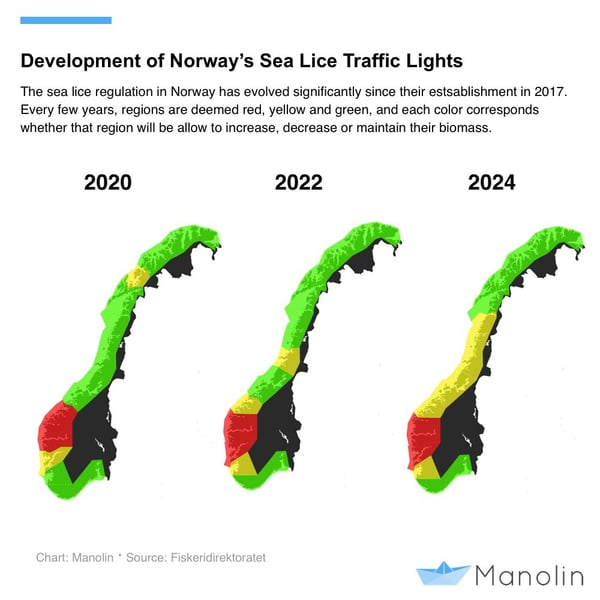Norway Sets New Traffic Light Designations for 2024
 By
Manolin
·
2 minute read
By
Manolin
·
2 minute read
Norway has recently unveiled updates to its Traffic Light System for 2024, a critical measure for the management of its salmon farms. These latest adjustments shed light on the implications for salmon farms across the country's production areas. Let's delve into the outcomes of this update and explore what they signify for the future of Norway's salmon farming industry.
Apart from production areas 6 and 8, the 2024 designations bear a striking resemblance to those of 2022. With the notable exception of PO8, the patterns in government area designations align very closely with each production area's trend of mortality exposure of sea lice on wild salmon.
For those new to the concept of the traffic light system and its significance, we provide a comprehensive breakdown of this system and its implications below.

What's Norway's Traffic Light System?
Norway's Traffic Light System is a risk-based management framework used to regulate salmon farming operations across different regions of the country. This system categorizes regions into three colors—green, yellow, and red—based on the environmental risk of sea lice infestation and its impact on wild salmon populations. A green classification indicates low risk, allowing for sustainable growth in salmon farming; yellow signals moderate risk, permitting limited growth; and red denotes high risk, leading to a reduction or halt in production to protect the ecosystem. By adapting farming practices to the ecological capacity of each region, the Traffic Light System aims to balance the growth of the aquaculture industry with the preservation of marine biodiversity.
How does Norway evaluate sea lice for the traffic light system?
In Norway, the government adopts a comprehensive approach to monitor and evaluate the impact of sea lice on wild salmon populations, particularly focusing on the mortality exposure levels. This evaluation is carried out annually during the spring months of April and May, utilizing various methods to gather data on sea lice infestation. The key metrics calculated from this data include the percentage of fish infested with any lice, the average number of lice per fish, and the percentage of fish with more than 10% of their body covered by lice. The 10% coverage threshold is critical because laboratory studies have shown that beyond this level of infestation, salmon are at a significant risk of mortality due to the parasitic burden.
To accurately assess the situation, the government employs three distinct sampling methods, each serving a unique purpose:
Bait & Net Sampling
This method involves fishing using bait and nets along predetermined routes that are checked daily. The primary aim here is to record the number of lice on each salmon and note the date of capture, providing immediate data on lice infestation levels in different areas.
Salmon Trawling
Trawling operations are conducted using boats equipped with nets designed to capture salmon in the outer parts of fjords. This method focuses on assessing the cumulative impact of sea lice on smolts (young salmon) as they migrate to the open ocean. Special care is taken to ensure that the nets capture wild smolts of the appropriate size, minimizing harm to the fish during the process.
Strategically Placed Cages
The government also utilizes cages, each containing 30 farmed smolts, strategically placed in the water. These cages are replaced every two weeks, providing continuous data on how sea lice infection pressures fluctuate over the season. The cages are usually positioned about one meter below the water's surface, simulating conditions that wild smolts might encounter.
What do the new updates mean for farms in Norway?
Although the recent designations are poised to introduce significant frustrations for farms, primarily through constraints and reductions in production capabilities, our team has pinpointed several encouraging trends within the data that should instill optimism among farmers as they advance into the year. A particularly uplifting highlight is the revelation that the overall female sea lice pressure across Norway's production areas did not surpass the 100 million threshold for the first time in a span of six years (2019 - 2024), a milestone depicted in the graph below. Furthermore, as we move into the period of wild smolt migration, the country is off to one of its most promising starts to the year we've recently observed.